Java 审计之SSRF篇
Java 审计之SSRF篇
0x00 前言
本篇文章来记录一下Java SSRF的审计学习相关内容。
0x01 SSRF漏洞详解
原理:
服务端提供了从其他服务器应用获取数据的功能且没有对目标地址做过滤与限制。
大部分的web服务器架构中,web服务器自身都可以访问互联网和服务器所在的内网。
ssrf作用:
对外网服务器所在的内网、本地进行端口扫描,获取一些服务的banner信息 。
攻击运行在内网或者本地的应用程序。
对内网web应用进行指纹识别,通过访问默认文件实现 。
攻击内外网的web应用。sql注入、struct2、redis等。
利用file协议读取本地文件等。
php ssrf中的伪协议:
file dict sftp ldap tftp gopher
Java ssrf 中的伪协议:
file ftp mailto http https jar netdoc
0x02 SSRF产生过程
在java中ssrf会分比较多的场景,不像PHP中那样支持各种伪协议都可以去直接使用。
SSRF中内网探测
@WebServlet("/ssrfServlet")
public class ssrfServlet extends HttpServlet {
protected void doPost(HttpServletRequest request, HttpServletResponse response) throws ServletException, IOException {
this.doGet(request, response);
}
protected void doGet(HttpServletRequest request, HttpServletResponse response) throws ServletException, IOException {
String url = request.getParameter("url"); //接收url的传参
String htmlContent;
PrintWriter writer = response.getWriter(); //获取响应的打印流对象
URL u = new URL(url); //实例化url的对象
try {
URLConnection urlConnection = u.openConnection();//打开一个URL连接,并运行客户端访问资源。
HttpURLConnection httpUrl = (HttpURLConnection) urlConnection; //强转为HttpURLConnection
BufferedReader base = new BufferedReader(new InputStreamReader(httpUrl.getInputStream(), "UTF-8")); //获取url中的资源
StringBuffer html = new StringBuffer();
while ((htmlContent = base.readLine()) != null) {
html.append(htmlContent); //htmlContent添加到html里面
}
base.close();
writer.println(html);//响应中输出读取的资源
writer.flush();
} catch (Exception e) {
e.printStackTrace();
writer.println("请求失败");
writer.flush();
}
}
在代码中HttpURLConnection httpUrl = (HttpURLConnection) urlConnection;,这个地方进行了强制转换,去某度搜索了一下具体用意。得出结论:
URLConnection:可以走邮件、文件传输协议。
HttpURLConnection 只能走浏览器的HTTP协议
也就是说使用了强转为HttpURLConnection后,利用中只能使用http协议去探测该服务器内网的其他应用。
http://localhost:8080/ssrfServlet?url=http://www.baidu.com
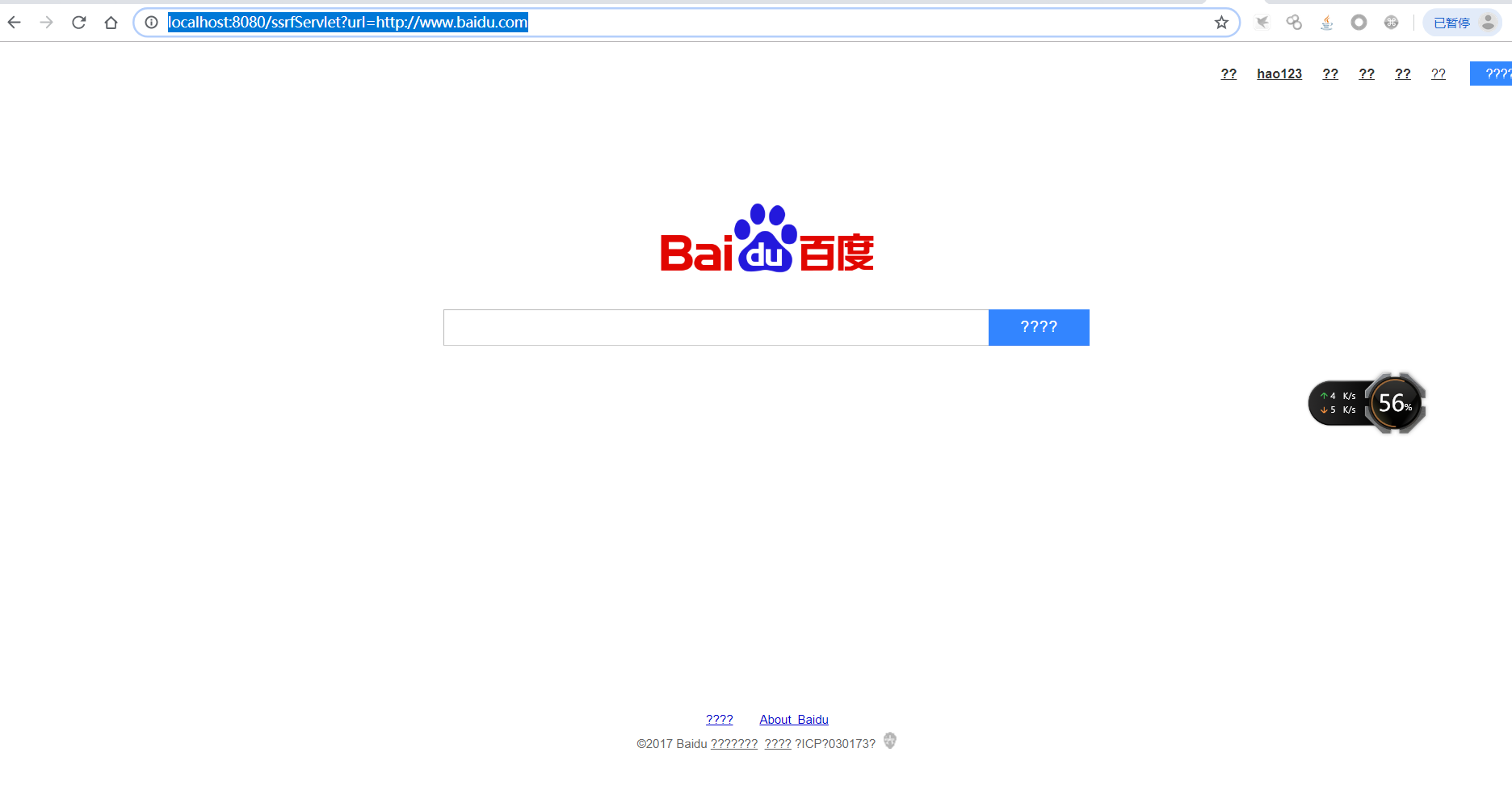
这里用来百度来做一个演示,因为懒得自己再在内网中搭建一个环境了。
在代码中,我们未对接收过来的url进行校验,校验其url是否是白名单的url就直接进行了创建url对象进行访问和读取资源,导致了ssrf的产生。
尝试一下能不能读取文件
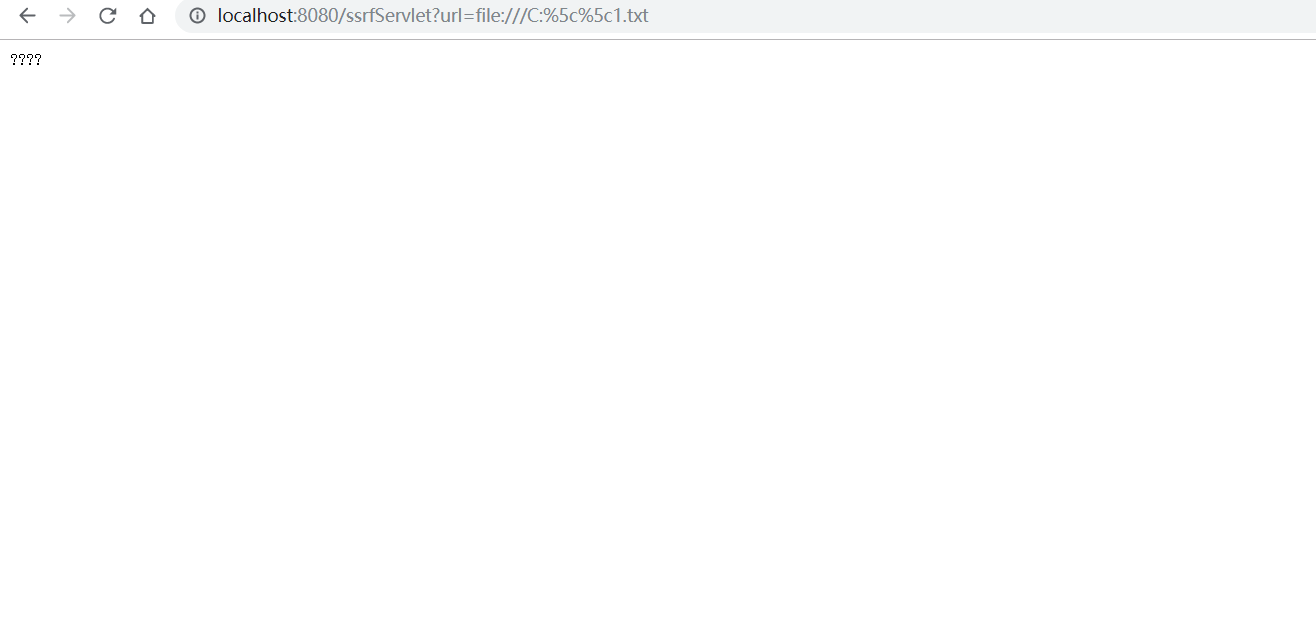
这里会发现根本读取不了,因为这里只支持http和https的协议。
下面来试试,在不强制转换成HttpURLConnection的情况下试试。
代码如下:
@WebServlet("/ssrfServlet")
public class ssrfServlet extends HttpServlet {
protected void doPost(HttpServletRequest request, HttpServletResponse response) throws ServletException, IOException {
this.doGet(request, response);
}
protected void doGet(HttpServletRequest request, HttpServletResponse response) throws ServletException, IOException {
String url = request.getParameter("url"); //接收url的传参
String htmlContent;
PrintWriter writer = response.getWriter(); //获取响应的打印流对象
URL u = new URL(url); //实例化url的对象
try {
URLConnection urlConnection = u.openConnection();//打开一个URL连接,并运行客户端访问资源。
// HttpURLConnection httpUrl = (HttpURLConnection) urlConnection; //强转为HttpURLConnection
BufferedReader base = new BufferedReader(new InputStreamReader(urlConnection.getInputStream(), "UTF-8")); //获取url中的资源
StringBuffer html = new StringBuffer();
while ((htmlContent = base.readLine()) != null) {
html.append(htmlContent); //htmlContent添加到html里面
}
base.close();
writer.println(html);//响应中输出读取的资源
writer.flush();
} catch (Exception e) {
e.printStackTrace();
writer.println("请求失败");
writer.flush();
}
http://localhost:8080/ssrfServlet?url=file:///c:%5c%5cwindows%5c%5cwin.ini
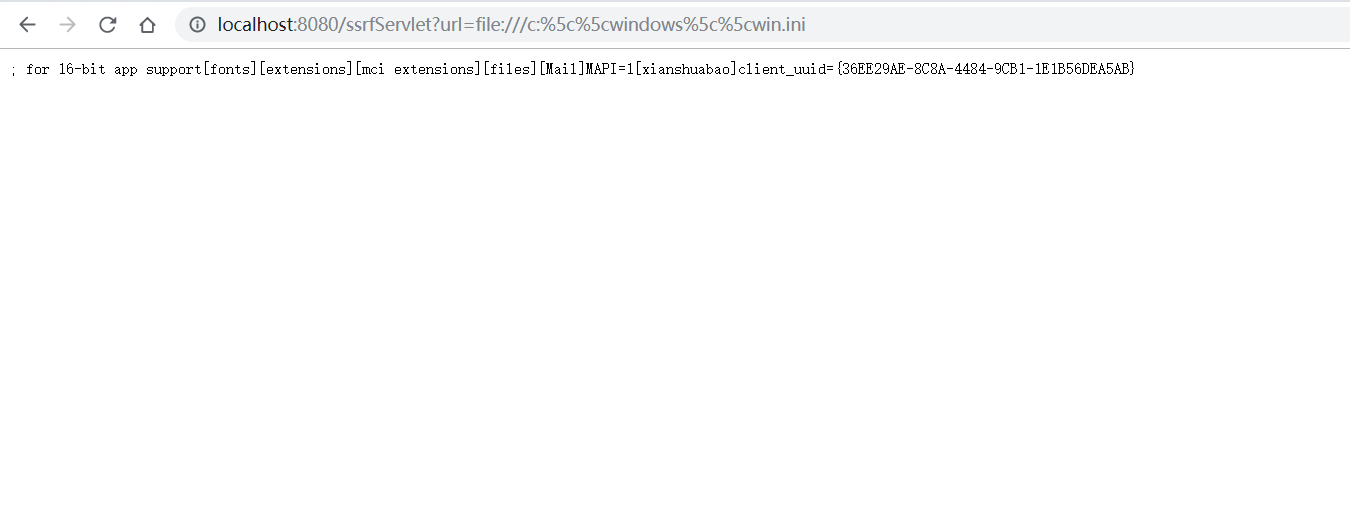
可以成功读取到c:\windows\win.ini的文件。
SSRF中的读取文件
代码如下:
@WebServlet("/readfileServlet")
public class downloadServlet extends HttpServlet {
protected void doPost(HttpServletRequest request, HttpServletResponse response) throws ServletException, IOException {
this.doGet(request,response);
}
protected void doGet(HttpServletRequest request, HttpServletResponse response) throws ServletException, IOException {
String url = request.getParameter("url");
int len;
OutputStream outputStream = response.getOutputStream();
URL file = new URL(url);
byte[] bytes = new byte[1024];
InputStream inputStream = file.openStream();
while ((len = inputStream.read(bytes)) > 0) {
outputStream.write(bytes, 0, len);
}
}
}
和上面的代码对比一下,发现其实都大致相同,唯一不同的地方是一个是用openStream方法获取对象,一个是用openConnection获取对象。两个方法类似。
官方说明文档:
openConnection():返回一个实例,该实例表示与所引用的远程对象的连接。 返回类型: URLConnection
openStream():打开与此连接,并返回一个值以从该连接读取。 返回类型: InputStream
详细说明:
openConnection:返回一个URLConnection对象,它表示到URL所引用的远程对象的连接。每次调用此URL的协议处理程序的openConnection方法都打开一个新的连接。如果URL的协议(例如,HTTP或JAR)存在属于以下包或其子包之一的公共、专用URLConnection子类:java.lang、java.io、java.util、java.net,返回的连接将为该子类的类型。例如,对于HTTP,将返回HttpURLConnection,对于JAR,将返回JarURLConnection。(返回到该URL的URLConnection!)
openStream():打开到此URL的连接并返回一个用于从该连接读入的InputStream。
这里启动一下服务器,测试一下。
http://127.0.0.1:8080//downloadServlet?url=file:///C:%5c%5c1.txt
注意: 这里是三个斜杆,并且反斜杠需要url编码 否则就会报错

未经过url编码直接传入反斜杠
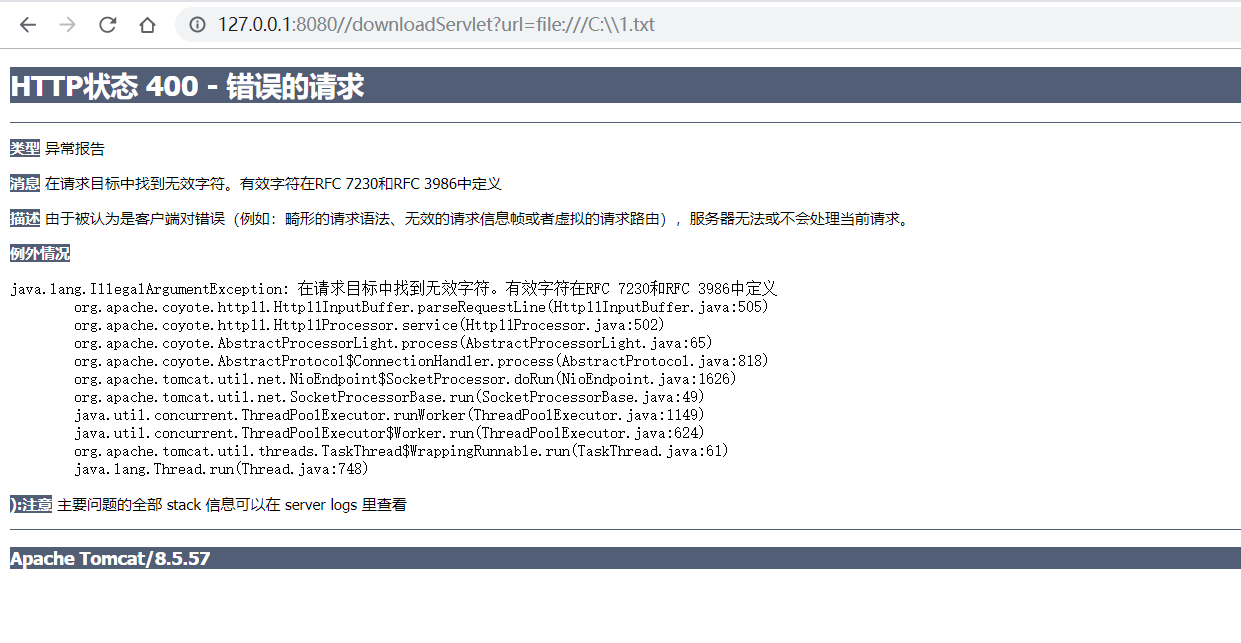
SSRF中的文件下载
漏洞代码:
@WebServlet("/downloadServlet")
public class downloadServlet extends HttpServlet {
protected void doPost(HttpServletRequest request, HttpServletResponse response) throws ServletException, IOException {
this.doGet(request,response);
}
protected void doGet(HttpServletRequest request, HttpServletResponse response) throws ServletException, IOException {
String filename = "1.txt";
String url = request.getParameter("url");
response.setHeader("content-disposition", "attachment;fileName=" + filename);
int len;
OutputStream outputStream = response.getOutputStream();
URL file = new URL(url);
byte[] bytes = new byte[1024];
InputStream inputStream = file.openStream();
while ((len = inputStream.read(bytes)) > 0) {
outputStream.write(bytes, 0, len);
}
}
}
输入:
http://localhost:8080/downloadServlet?url=file:///c:%5c%5c1.txt
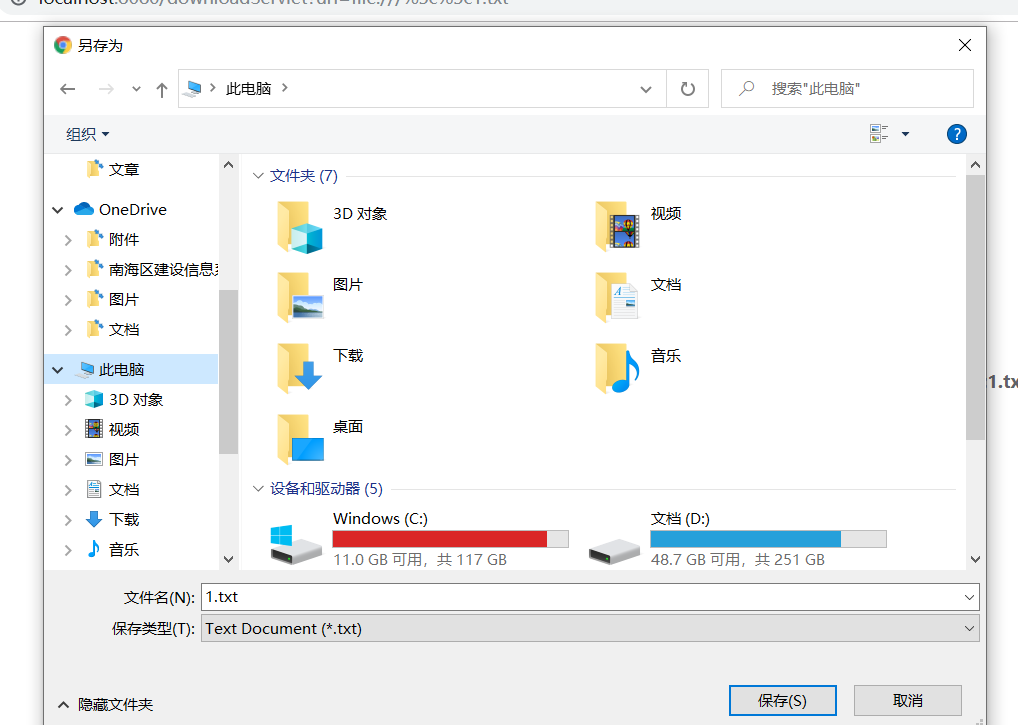
这样就把文件给下载下来了,ssrf中的文件下载和文件读取不同点在于响应头。
response.setHeader("content-disposition", "attachment;fileName=" + filename);
这段代码,设置mime类型为文件类型,访问浏览器的时候就会被下载下来。
参考文章
https://xz.aliyun.com/t/2761#toc-1
https://xz.aliyun.com/t/206/
https://xz.aliyun.com/t/7186
0x03 结尾
SSRF的一些产生也不止文章里面写到的这么一点,包括一些第三方的组件,如果在未经过验证的情况下发起一个远程请求,那么都有可能存在SSRF漏洞。
后面打算找套源码专门审计一下SSRF。
最新文章
- CDS
- eclips引入Java源代码
- [转载]AFX_MANAGE_STATE关于资源切换
- java反射机制(工厂模式)
- js中的apply call 操作小结(参考自网络)
- zepto.1.1.6.js源码中的each方法学习笔记
- boost asio io_service学习笔记
- Android源代码同步脚本(增加设置线程参数)
- javascript中的面向对象—— 学习1
- C++设计模式-Iterator迭代器模式
- 这是一篇关于:以时间表的形式来介绍Java如何演变至今,以及Java版本的一些特性的分享
- 为什么使用正则test( )第一次是 true,第二次是false?
- Django练习——TodoList
- 在SpringBoot中使用热部署(DevTools)
- [转载]从100PV到1亿级PV网站架构演变
- C# 通过api函数GetPrivateProfileString读取ini文件,取不到值
- iOS美丽约网络请求分析
- linux下查看当前目录属于哪个分区?
- android activity and fragment活动周期
- ruby 中的 module